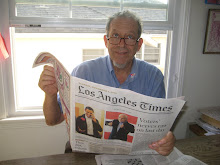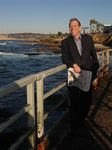TREASON WITH THE ATOM
More evil than reptilian,
destructive as a million
A-bombs, and discovered
by scientists who hovered
above the surface of
the chaos God with love
transformed with primal light,
than H-bombs far more bright,
the weapon from Los Alamos
developed in the thalamus,
the lowbrain that destroys
tranquillity with noise.
Producing such a nuke
could not have been a fluke,
and now that it exists,
though primal light persists,
mere humans can be rashand put out in a flash
the brilliant inspiration
that started the creation.
Explained by Einstein first,
the process led to thirst
for knowledge––not from trees,
but PhD degrees.
Let’s say goodbye to Adam,
for treason with the atom
more treacherous than trees
that merely made him freeze
when naked in the Garden,
leaves him no chance of pardon
from God, who’s washed His hands
of earth and its badlands.
Belief in Him, outmoded,
has long ago exploded,
and nuclear is our
rejection of His power.
All flesh is bound to pass,
but now’s the time for mass
destruction. Hello Atom,
we’ll see you in Manhattan,
if not first in Jeru-
salem if you’re a Jew.
Inspired by an article in the NYT by William J. Broad, reviewing a book by Thomas C. Reed and Danny B. Stillman suggesting that the H-bomb devised by Andrei Sakharov in 1955 was probably based on the one invented Edward Teller and Stanislaw M. Ulam in 1951. (“Soviets Stole Bomb Idea From IU.S., Book Says,” NYT, December 30, 2008:
A defining moment of the cold war came in 1955 when Moscow detonated its first hydrogen bomb — a weapon roughly a thousand times more powerful than atom bombs and ideal for obliterating large cities. The bomb ended the American monopoly and posed a lethal danger. So Washington dealt far more gingerly with Moscow, beginning a tense era dominated by fear of mutual annihilation.Now, a new book says Moscow acquired the secret of the hydrogen bomb not from its own scientists but from an atomic spy at the Los Alamos weapons lab in New Mexico. Historians call its case sketchy but worthy of investigation, saying the book, “The Nuclear Express: A Political History of the Bomb and its Proliferation,” by Thomas C. Reed and Danny B. Stillman, adds to a growing number of riddles about who invented the Soviet H-bomb a half century ago. “It’s quite intriguing,” Robert S. Norris, a nuclear historian, said of the book. “We’ve learned a lot about atomic spies. Now, we find out that a spy may be at the center of the H-bomb story, too.” A surprising clue the authors cite is disagreement among Russian nuclear scientists over who deserves credit for the advance as well as some claims that espionage played a role. The book details this Russian clash and questions the popular idea that Andrei D. Sakharov, who later became known as a campaigner for human rights, independently devised the Soviet hydrogen bomb. The book does not name the suspected spy but says he was born in the United States, grew up in a foreign country, fell in with communist sympathizers during the depression, and worked at Los Alamos during World War II. Afterward, it says, he became “deeply involved” in the American effort to develop the H-bomb.
© 2008 Gershon Hepner 12/30/08
Tuesday, December 30, 2008
Subscribe to:
Post Comments (Atom)


Interesting poetry of an informative 'impulse'...
ReplyDeleteYes, about it it is take documentary films...
Especial the role was played by the Beria …
But, «and now that it exists,
though primal light persists, »
Mankind should play, this 'game' up to the end...
Nice...
I wonder whether, when you say that mankind should play this game up to the end, you imply that the game may lead to the end.
ReplyDelete